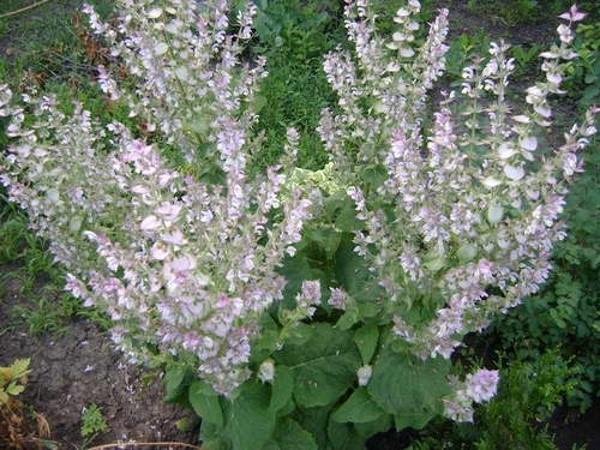Growing clary sage in the garden
 If you want to decorate your flower bed with a flowering fragrant bush - master the cultivation of clary sage. In addition to the amazing scent emanating from the lush, delicate buds, you will always have a spicy seasoning on hand. And this plant will help get rid of many diseases, moreover, it is absolutely unpretentious. Having picked up a cozy place in the garden for sage, you will only have to occasionally visit him with a watering can or secateurs.
If you want to decorate your flower bed with a flowering fragrant bush - master the cultivation of clary sage. In addition to the amazing scent emanating from the lush, delicate buds, you will always have a spicy seasoning on hand. And this plant will help get rid of many diseases, moreover, it is absolutely unpretentious. Having picked up a cozy place in the garden for sage, you will only have to occasionally visit him with a watering can or secateurs.
Although clary sage is a perennial crop, it usually has a two-year life cycle in the garden. In the first year, the bush grows roots and leaves, and fragrant flowering occurs in the second season. At the same time, fruit-seeds are set, which crumble to the ground and sprout in the third spring.
Description of the plant
Clary sage grows in the form of a herbaceous shrub of quite decent size. The height of the stems reaches 1 m, and in well-lit places it can even reach up to 1.5 m. The bush has a developed root-rod that goes deep into the ground. In the first year of life, he builds up a lush rosette of beautiful large leaves. The leaf plate is corrugated, wrinkled, covered with a light grayish fluff.
In the second year of its life, sage produces a powerful peduncle in the spring. It rises above the leaves and is strewn with long spike-shaped inflorescences. They consist of many small flowers of a pale pink color and emit a breathtaking aroma. In short, it is impossible to describe it: it is a mixture of lily of the valley, rose, lavender and a little lemon. By September, sage seeds ripen, and it reproduces by self-sowing.
Growing clary sage
For a beautiful and healing sage garden, you need to take the brightest spot in the garden. Sage is picky about lighting: in the shade, its stems begin to develop faster than leaves. Not only the leaf plate becomes smaller, but also the inflorescences, moreover, they become smaller. The plant is not demanding on the soil, but it will bloom more abundantly on fertile loose soil. Sage grows best on loam and sandy loam.
The most affordable way to get hold of sage is to buy and sow seeds. This can be done in several ways:
- For seedlings. In March, sow the seeds in pots, and in mid-May, transplant the seedlings to a flower bed.
- In April, sow sage directly into the ground.
- Sow seeds before winter at the end of October.
Growing clary sage is easy, because its care is simple and not capricious. The bushes tolerate drought well, but it is still better to water them regularly for abundant flowering. During the period of active growth, in the spring, you can feed it with a mineral complex. The plant overwinters well, but in order for it to really grow for several years, it is advisable to cover the beds. In the second year of life, if seeds are not needed, the stems can be shortened.